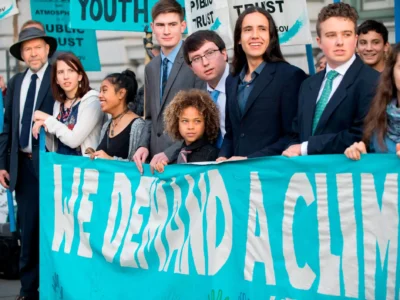California Supreme Court Upholds Regional Planning Agency’s Greenhouse Gas CEQA Analysis, and Sets Out Principles to Ensure Better Analysis in the Future
Decision Will Help Ensure Development and Transportation Planning in California Supports GHG Reduction Efforts
In May, Rick Frank posted his reflections on the oral argument in the California Supreme Court on Cleveland National Forest Association v. San Diego Association of Governments (SANDAG), and predicted that SANDAG would win the case. His prediction has proved correct with the release of the Court’s opinion last week – but SANDAG’s narrow win provides a lot to be cheer about for advocates and policymakers who want to ensure that new development and transportation planning in California helps, rather than hinders, our statewide greenhouse gas reduction efforts. [Disclosure: UCLA’s Frank G. Wells Environmental Law Clinic, through the work of my colleague Cara Horowitz and several students, filed an amicus curiae brief in this case on behalf of a group of scientists, supporting the plaintiffs.]
Several prior Legal Planet posts have covered the issues in this case (including this detailed discussion by Rick after the Court accepted the case for review, this one by Rick after the case was calendared, and this analysis by Ethan Elkind after the Court of Appeal opinion was issued) so I’ll just summarize them here briefly. The plaintiffs – who included the California Attorney General as well as multiple advocacy groups – challenged the legal adequacy of the Environmental Impact Report (EIR) for SANDAG’s 2011 regional transportation plan, a legally-mandated plan setting forth a multi-decade strategy for meeting future transportation needs in the San Diego region. At issue was the plan’s implications for future emissions of greenhouse gases, and whether the EIR did a good enough job explaining and addressing those implications. The plaintiffs, including the Attorney General, alleged that the EIR didn’t do a good enough job. They asserted that the EIR insufficiently disclosed and analyzed the plan’s inconsistency with state greenhouse gas reduction goals articulated in an executive order that required 80% reductions in greenhouse gas emissions by 2050. They also claimed that the EIR failed to adequately consider alternatives and mitigation measures to reduce future emissions. Both the trial court and Court of Appeal agreed with the plaintiffs that the environmental review was inadequate.
The Supreme Court granted review on one issue: “Must the environmental impact report for a regional transportation plan include an analysis of the plan’s consistency with the greenhouse gas emission reduction goals reflected in Executive Order No. S-3-05 to comply with the California Environmental Quality Act?” The Court did not, however, review the Court of Appeal’s judgment that the EIR didn’t sufficiently consider mitigation or alternatives.
All the parties’ briefs are archived here, for anyone who might be interested.
Rick and I both attended the oral argument in May 2017. Rick made this prediction after the argument:
It was surprising–at least to this observer–that the other five justices left almost all of the questioning in the Cleveland National Forest case to Justices [Goodwin] Liu and [Mariano-Florentino] Cuellar. That suggests two things to me: first, that either Justice Liu or Cuellar will wind up writing the Court’s opinion in the case. Second, if the EIR challengers were unable to convince Liu and Cuellar of the merits of their case, they stand little chance of capturing the votes of the Court’s more moderate members. Bottom line … : I expect the Supreme Court to reverse the lower courts in this case and conclude that the San Diego Association of Government’s EIR in this landmark CEQA and climate change case is legally adequate.
The Supreme Court’s opinion, released last week, bore out Rick’s prediction that the Court would reverse the Court of Appeal on the issue presented and find the greenhouse gas analysis’s treatment of long-term emissions in light of the executive order was adequate. The Court noted that
Although there were perhaps clearer or more graphic ways the EIR could have facilitated a comparison between 2050 projected emissions and the Executive Order‘s 2050 emissions reduction target, we find that the EIR presented the information enabling that comparison ―in a manner calculated to adequately inform the public and decision makers, who may not be previously familiar with the details of the project.
The Court went on to say that “SANDAG did not abuse its discretion in declining to adopt the 2050 goal as a measure of significance in light of the fact that the Executive Order does not specify any plan or implementation measures to achieve its goal.” And finally, the Court noted:
Nor can we say it was unreasonable for SANDAG to use its threefold approach in the EIR: (1) Where statute and regulation provide specific regional emissions reduction targets, as for cars and light trucks for 2020 and 2035, the EIR analyzes consistency of projected emissions with those targets …. (2) For longer-term emissions through 2050, for which no statute or regulation provides regional or sector targets, the EIR analyzes projected emissions against a baseline of current emissions …. This is one of the approaches specified in Guidelines section 15064.4, subdivision (b), which calls on lead agencies to consider ―[t]he extent to which the project may increase or reduce greenhouse gas emissions as compared to the existing environmental setting. (3) The EIR analyzes whether the Plan incorporates land use changes and transportation improvement designed to reduce emissions, as reflected in SANDAG‘s Climate Action Strategy and CARB‘s Scoping Plan (GHG-3). … Whether or not any one method, by itself, would have provided sufficient analysis, we conclude that these three methods 23 together adequately informed readers of potential greenhouse gas emission impacts.
So SANDAG won the Supreme Court case. Nonetheless, the opinion was framed very narrowly, and reaffirms that an Environmental Impact Statement for a planning project must develop a robust analysis of greenhouse gas emissions under the plan. Here, I’ll explain why the opinion will ensure that local governments and courts seriously and rigorously consider greenhouse gas emissions when they develop plans for future growth, development, and transportation.
The Court’s opinion articulated three strong principles: In their CEQA review of planning documents, agencies have to take seriously the significance of even small incremental greenhouse gas emissions in a statewide and global context. They must consider and incorporate science-based state policy guidance into their decisionmaking, even if that guidance doesn’t have the force of law. And they are required to use the best scientific information available, updated as that information improves, to determine whether planning decisions are consistent with the state’s goals.
The Court noted first, in response to arguments by SANDAG, that “an EIR‘s designation of a particular adverse environmental effect as significant does not excuse the EIR‘s failure to reasonably describe the nature and magnitude of the adverse effect.” It went on to observe – as decisions including Massachusetts v. EPA (U.S. Supreme Court) and Center for Biological Diversity v. California Dept. of Fish and Wildlife (California Supreme Court) have in the past – that even a small contribution to the worldwide challenge of climate change, and conversely a small contribution to reduction of the greenhouse gases that cause climate change, may be significant because both the problem and the solution are necessarily the aggregation of many small contributions:
SANDAG‘s conclusory statement that its role in achieving the Executive Order‘s 2050 emission reduction target is ―likely small is not a valid reason for rejecting the target as a measure of significance. As noted, ―because of the global scale of climate change, any one project‘s contribution is unlikely to be significant by itself. (Center for Biological Diversity, supra, 62 Cal.4th at p. 219.) The solution to climate change requires the aggregation of many small reductions in greenhouse gas emissions by public and private actors at all levels…. The fact that a regional plan‘s contribution to reducing greenhouse gas emissions is likely to be small on a statewide level is not necessarily a basis for concluding that its impact will be insignificant in the context of a statewide goal.
The Court went on to note that while local agencies have much discretion in determining the significance of impacts under CEQA, where, as in this case, state guidance is an expression or synthesis of scientific data and scientific judgment, agencies may not ignore it. In this case, while the Court found that the agency made adequate use of the guidance, it is apparent that had SANDAG simply ignored or dismissed the guidance, it would likely have lost this case.
Finally, and perhaps most significantly, the Court made clear that agencies analyzing greenhouse gas impacts of planning decisions must always use the best information available and must use that information to determine whether those decisions are consistent with the state’s goals:
Moreover, we caution that our conclusion that SANDAG did not abuse its discretion in its analysis of greenhouse gas emission impacts in the 2011 EIR does not mean that this analysis can serve as a template for future EIRs. Under CEQA, “[t]he determination of whether a project may have a significant effect on the environment calls for careful judgment on the part of the public agency involved, based to the extent possible on scientific and factual data.” (Guidelines, § 15064, subd. (b).) As more and better data become available, analysis of the impact of regional transportation plans on greenhouse gas emissions will likely improve. Indeed, SANDAG explains that its EIR, in analyzing its 2015 regional transportation plan, “was able to account for many factors in the GHG inventories that were not accounted for in 2011, reflecting additional certainty regarding the regulatory environment, including future projections of renewable energy, building energy efficiency, water conservation programs, and solid waste 24 diversion.” A regional planning agency like SANDAG, charged with assisting the implementation of the state‘s climate goals, must straightforwardly address in the relevant environmental review documents whether its regional transportation plan as a whole is in accord with those goals. Its capacity to do so will likely improve over time.
Thus, while the decision was a win for SANDAG, it appears to have provided guidance for future cases that is largely consistent with the plaintiffs’ views of the level and type of analysis necessary to conduct an adequate review of the greenhouse gas impacts of agency plans. Moreover, the decision specifically left the other holdings of the Court of Appeal in this case – regarding the inadequacy of project mitigation and alternatives studied in the EIR – intact.
I read Justice Liu’s opinion, which was joined by five other Justices, as a masterful synthesis of what I expect were diverse views among the Justices. Based on the Court’s recent CEQA decisions, including Center for Biological Diversity v. California Dept. of Fish and Wildlife (Newhall Ranch), it is clear that the Justices’ views on CEQA’s role in addressing greenhouse gas emissions are varied; in particular, Justices Ming Chin and Carol Corrigan have expressed a more limited view of agency obligations to analyze greenhouse gas emissions under CEQA. This opinion by Justice Liu managed to provide a blueprint for robust CEQA analysis of greenhouse gas emissions, yet it attracted support from those more skeptical Justices, perhaps because of its moderate language and its ultimate holding that the agency had done a good enough job at its analysis in this case.
One Justice, Justice Cuellar, dissented, however. Justice Cuellar’s dissenting opinion would have required SANDAG to do more. Justice Cuellar believes that CEQA analysis of a regional transportation plan relates inextricably to the substantive requirements of SB 375, the law that mandated the regional transportation plans in the first place – and that that relationship means that CEQA analysis of such a plan has to be more transparent and rigorous. His dissenting opinion observes:
Though this EIR is governed by the same general framework that governs the validity of an EIR for a typical development project, it was also somewhat distinct in that the whole purpose of the project at issue — the entire reason the Legislature directed SANDAG to issue a regional transportation plan — was to help achieve the state‘s goal of reducing greenhouse gas emissions from transportation infrastructure. CEQA and SB 375 together created a duty to explain in detail whether SANDAG‘s regional transportation plan will work ―to the disadvantage of‖ that long-term goal. (Pub. Resources Code, § 21083, subd. (a)(1).) The Court of Appeal was persuaded by the Attorney General and other challengers that the EIR failed that requirement. I agree.
Justice Cuellar goes on to conclude:
No one is asking SANDAG to singlehandedly prevent California from blowing through its greenhouse gas emissions limits. But the agency was given a specific role in the state‘s coordinated climate change agenda: to reduce transportation emissions from the San Diego region. Under SANDAG‘s plan and according to its projections, the opposite will occur. While the agency is for the most part entitled to make that choice, it does not have discretion to downplay the consequence — one requiring blunter acknowledgement as the elephant in the room that it is. If SANDAG plans to permit hundreds of billions of dollars to be spent in pursuit of a plan that departs so starkly from scientific and political consensus about the emissions decreases needed to avert climate catastrophe, it must explain this divergence in sufficient detail for the public to recognize the long-term harm that will unfold in its name. SANDAG‘s EIR is too vague and shortsighted to fulfill that duty. In excusing this failure, the majority heightens the risk that other regional planners will shirk their responsibilities, too.
In other words, Justice Cuellar agreed with the plaintiffs that the fundamental role of the greenhouse gas analysis in this EIR should have been to ensure that the decisionmakers and public understood that SANDAG was not properly discharging its duty to reduce future greenhouse gas emissions from transportation. (As noted in earlier Legal Planet posts and in the Supreme Court decision, and as acknowledged by plaintiffs’ counsel at oral argument, an updated transportation plan released by SANDAG in the interim has cured those defects.) I am inclined to agree with Justice Cuellar’s analysis, and believe that his take on the decision is a better way of understanding the role of CEQA in planning – especially since land use and transportation plans provide a crucial opportunity for future GHG reduction from future land use changes and transportation networks, and CEQA review of those plans is an important means to ensure that opportunity is taken. But I’m more optimistic than he is about the way this decision will guide future analysis.
One final note: The advocates in the Supreme Court did an admirable job. Michael Zischke of Cox, Castle, and Nicholson, facing a friendly bench, was able to support and bolster the Court’s ultimate view that SANDAG properly considered the executive order. And the advocacy of Kevin Bundy (Center for Biological Diversity) and Janill Richards (California Attorney General, Solicitor General’s Office) surely motivated the Court to keep its opinion narrow and to set forth principles requiring robust analysis in future EIRs. They ably responded to the Justices’ very pointed and skeptical questions about their arguments, and the opinion’s language was far more favorable to the plaintiffs than I would have expected after watching the arguments. Moreover, as Rick pointed out, Justice Cuellar’s questions at oral argument were very pointed and challenging for the plaintiffs – but in the end he adopted their view of the case in his dissent.
The principles the Court articulates in this case will be influential as California’s public agencies continue to grapple with how to address climate change in their land-use and transportation planning and decisionmaking. I look forward to seeing how California’s efforts to address climate change through its local government planning processes unfold in the coming years.
[Note: Some portions of the text above have been updated since this post was published, to clarify some points and add some reflections that weren’t in the original post.]
Reader Comments
One Reply to “California Supreme Court Upholds Regional Planning Agency’s Greenhouse Gas CEQA Analysis, and Sets Out Principles to Ensure Better Analysis in the Future”
Comments are closed.








“…….that even a small contribution to the worldwide challenge of climate change, and conversely a small contribution to reduction of the greenhouse gases that cause climate change, may be significant because both the problem and the solution are necessarily the aggregation of many small contributions….”
SANDAG fails to provide even a small contribution towards mitigating climate change, its contribution, if any, is too small to measure and confirm. There are no generally accepted standards for climate mitigation and no performance guarantees and warranties, and other binding legal requirements to actually mitigate climate. None at all. Climate mitigation is not technically and economically feasible, but it continues to be hyped especially in California.
SANDAG increases the difficulty, costs and risks of developing new residential construction projects in California, and it contributes to the scourge of homelessness statewide. SANDAG fails to mitigate climate change. What good does it proffer?